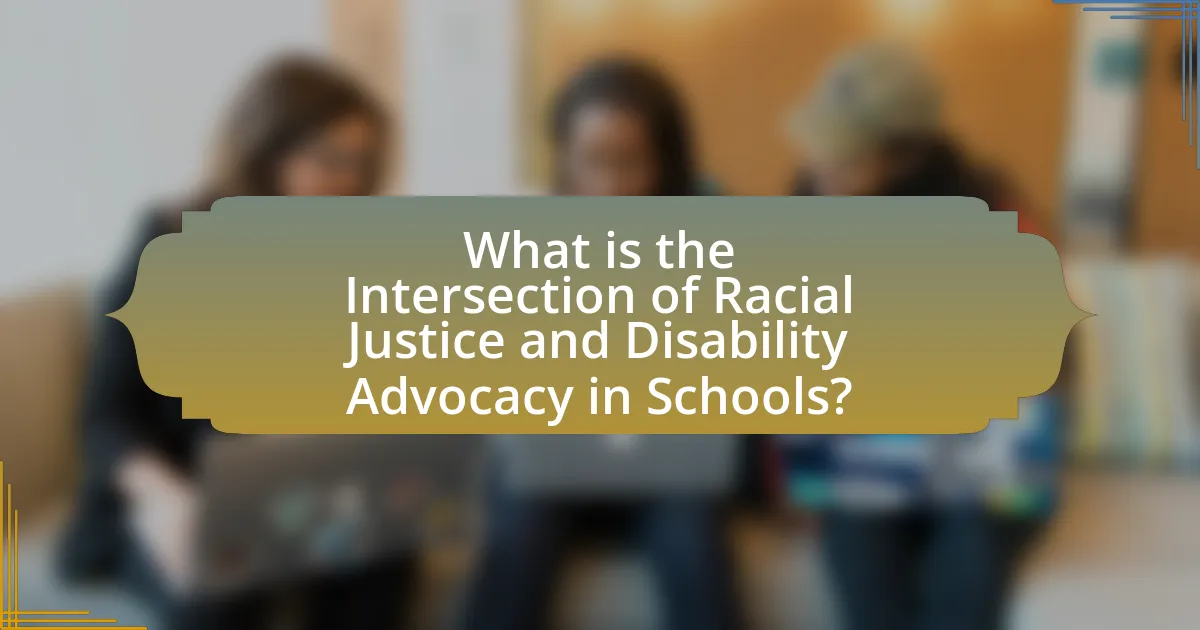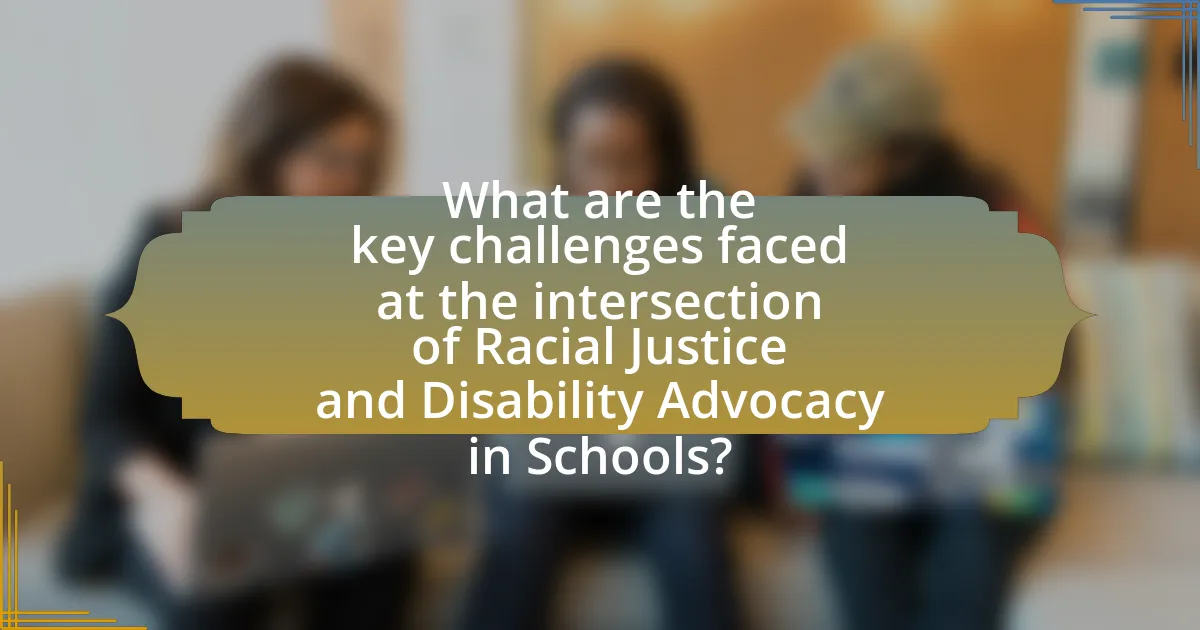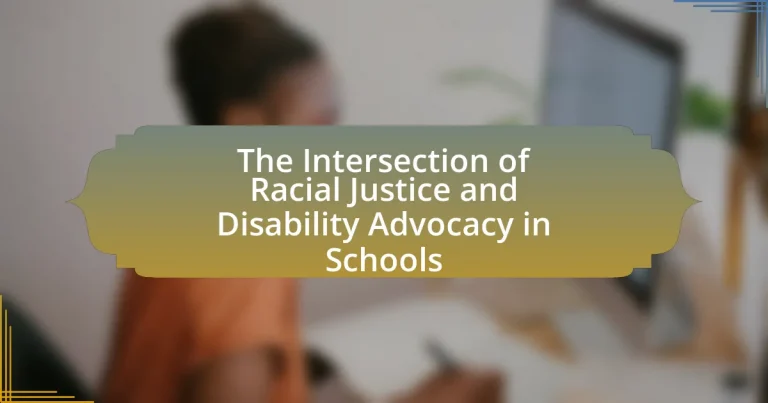The article examines the intersection of racial justice and disability advocacy in schools, highlighting the systemic racism and ableism that disproportionately affect marginalized students, particularly Black students with disabilities. It discusses the historical contexts that have shaped these movements, the impact of systemic inequalities on educational outcomes, and the importance of inclusive policies that address both racial and disability discrimination. Key challenges, such as inadequate resources and biases, are explored, along with strategies for educators to promote inclusivity and support for affected students. The article emphasizes the necessity of collaboration with community organizations and the role of curriculum in fostering awareness and understanding of these critical issues.

What is the Intersection of Racial Justice and Disability Advocacy in Schools?
The intersection of racial justice and disability advocacy in schools refers to the overlapping issues of systemic racism and ableism that affect marginalized students. Both racial minorities and students with disabilities often face discrimination, leading to disparities in educational opportunities, resources, and support. For instance, studies show that Black students with disabilities are disproportionately represented in special education programs and are more likely to be subjected to disciplinary actions compared to their white peers. This intersectionality highlights the need for inclusive policies that address both racial and disability inequities, ensuring that all students receive equitable access to quality education and support services.
How do racial justice and disability advocacy intersect in educational settings?
Racial justice and disability advocacy intersect in educational settings by highlighting the systemic inequalities faced by marginalized groups, particularly students of color with disabilities. Research indicates that students with disabilities, especially those from racial and ethnic minority backgrounds, experience higher rates of disciplinary actions and lower academic achievement compared to their peers. For instance, a report by the U.S. Department of Education shows that Black students with disabilities are disproportionately represented in suspensions and expulsions, which exacerbates educational disparities. This intersection emphasizes the need for inclusive policies that address both racial and disability discrimination, ensuring equitable access to resources and support for all students.
What historical contexts have shaped the intersection of these movements?
The historical contexts that have shaped the intersection of racial justice and disability advocacy in schools include the civil rights movement of the 1960s and the disability rights movement of the 1970s. The civil rights movement aimed to dismantle systemic racism and promote equal rights for African Americans, leading to significant legislative changes such as the Civil Rights Act of 1964. Concurrently, the disability rights movement sought to address discrimination against individuals with disabilities, culminating in the passage of the Individuals with Disabilities Education Act (IDEA) in 1975, which mandated free and appropriate public education for students with disabilities. These movements intersected as advocates recognized the overlapping challenges faced by marginalized groups, leading to collaborative efforts that emphasized inclusive education and equitable treatment for all students, regardless of race or disability.
How do systemic inequalities impact students with disabilities from racial minorities?
Systemic inequalities significantly impact students with disabilities from racial minorities by exacerbating barriers to access and support in educational settings. These students often face compounded challenges due to both their racial identity and their disabilities, leading to higher rates of exclusion from mainstream education, lower academic achievement, and increased disciplinary actions. For instance, a study by the National Center for Learning Disabilities found that Black students with disabilities are more likely to be placed in segregated settings compared to their white peers, limiting their educational opportunities and social integration. Additionally, systemic biases in school funding and resources often result in inadequate support services for these students, further hindering their academic success and overall well-being.
Why is it important to address both racial justice and disability advocacy in schools?
Addressing both racial justice and disability advocacy in schools is crucial because it ensures equitable access to education for all students, regardless of their race or ability. Research indicates that students from marginalized racial backgrounds and those with disabilities often face systemic barriers that hinder their academic success and social integration. For instance, a report by the National Center for Learning Disabilities highlights that students of color with disabilities are disproportionately represented in special education programs, which can lead to lower educational outcomes. By integrating racial justice and disability advocacy, schools can create inclusive environments that promote diversity, foster understanding, and support the unique needs of every student, ultimately leading to improved educational equity and social cohesion.
What are the consequences of neglecting these issues in educational policies?
Neglecting issues of racial justice and disability advocacy in educational policies leads to systemic inequities that adversely affect marginalized students. These consequences manifest as increased dropout rates, lower academic achievement, and a lack of access to necessary resources and support services. For instance, research indicates that students of color with disabilities are disproportionately subjected to disciplinary actions, which can hinder their educational progress and contribute to the school-to-prison pipeline. Furthermore, the absence of inclusive policies can perpetuate stereotypes and discrimination, ultimately fostering an environment that fails to support the diverse needs of all students.
How can addressing these intersections improve educational outcomes?
Addressing the intersections of racial justice and disability advocacy can significantly improve educational outcomes by creating an inclusive environment that meets the diverse needs of all students. Research indicates that when schools implement culturally responsive teaching practices and provide appropriate accommodations for students with disabilities, academic performance and engagement increase. For instance, a study by the National Center for Learning Disabilities found that students who receive tailored support are more likely to achieve higher test scores and graduation rates. By recognizing and addressing the unique challenges faced by students at these intersections, schools can foster equity, enhance student well-being, and ultimately lead to better educational achievements.

What are the key challenges faced at the intersection of Racial Justice and Disability Advocacy in Schools?
The key challenges faced at the intersection of racial justice and disability advocacy in schools include systemic inequities, lack of representation, and inadequate resources. Systemic inequities manifest in the disproportionate disciplinary actions against students of color with disabilities, which can lead to higher rates of suspension and expulsion compared to their peers. Research from the U.S. Department of Education indicates that Black students with disabilities are more likely to face harsher disciplinary measures than white students with similar disabilities. Additionally, the lack of representation in decision-making roles within schools often results in policies that do not adequately address the unique needs of these students. Furthermore, inadequate resources, such as insufficient funding for special education programs, exacerbate the challenges faced by students at this intersection, limiting access to necessary support services.
What barriers do students with disabilities from marginalized racial backgrounds encounter?
Students with disabilities from marginalized racial backgrounds encounter systemic barriers such as inadequate access to resources, discrimination, and cultural biases within educational settings. These barriers manifest in various ways, including limited availability of specialized support services, which affects their academic performance and social integration. Research indicates that students of color with disabilities are more likely to be placed in segregated classrooms and receive harsher disciplinary actions compared to their peers, exacerbating educational inequities. For instance, a study by the National Center for Learning Disabilities found that Black students with disabilities are disproportionately represented in special education programs, highlighting the intersection of racial and disability discrimination.
How do stereotypes and biases affect the treatment of these students?
Stereotypes and biases significantly impact the treatment of students with disabilities, particularly those from racial minority backgrounds, by leading to lower expectations and discriminatory practices. Research indicates that educators often hold implicit biases that can result in disproportionate disciplinary actions against these students, as evidenced by a study from the U.S. Department of Education showing that Black students with disabilities are more likely to face suspensions compared to their white counterparts. This unequal treatment stems from stereotypes that portray minority students as more disruptive or less capable, which can hinder their academic performance and social integration. Consequently, these biases not only affect the educational opportunities available to these students but also perpetuate systemic inequalities within the school environment.
What role does funding play in addressing these challenges?
Funding plays a crucial role in addressing the challenges at the intersection of racial justice and disability advocacy in schools by providing necessary resources for equitable educational opportunities. Adequate funding enables schools to implement programs that support diverse student needs, such as specialized training for educators, accessibility improvements, and culturally relevant curricula. For instance, the National Center for Education Statistics reported that schools with higher funding levels are better equipped to offer individualized support services, which can significantly improve outcomes for students with disabilities from marginalized racial backgrounds. Thus, targeted funding is essential for fostering an inclusive educational environment that promotes both racial equity and disability rights.
How can schools effectively advocate for both racial justice and disability rights?
Schools can effectively advocate for both racial justice and disability rights by implementing inclusive policies and fostering an environment of awareness and education. This involves integrating curricula that highlight the histories and contributions of marginalized groups, including people with disabilities and racial minorities, ensuring that all students see themselves represented. Additionally, schools should establish partnerships with local advocacy organizations to provide resources and training for staff on issues related to racial and disability justice. Research indicates that inclusive educational practices not only benefit marginalized students but also promote a more equitable school culture overall, as seen in studies conducted by the National Center for Learning Disabilities, which emphasize the importance of intersectionality in advocacy efforts.
What strategies can educators implement to promote inclusivity?
Educators can implement strategies such as differentiated instruction, culturally responsive teaching, and collaborative learning to promote inclusivity. Differentiated instruction allows educators to tailor their teaching methods to accommodate diverse learning styles and abilities, ensuring that all students can engage with the material effectively. Culturally responsive teaching incorporates students’ cultural references in all aspects of learning, which fosters a sense of belonging and respect for diversity. Collaborative learning encourages students to work together in diverse groups, promoting peer interaction and understanding among different backgrounds. Research indicates that these strategies not only enhance academic performance but also contribute to a more equitable and inclusive classroom environment, as evidenced by studies showing improved student engagement and reduced achievement gaps among marginalized groups.
How can collaboration with community organizations enhance advocacy efforts?
Collaboration with community organizations can enhance advocacy efforts by leveraging local knowledge, resources, and networks to amplify voices and address specific issues effectively. When advocacy groups partner with community organizations, they gain access to a broader base of support, which can lead to increased visibility and impact. For instance, community organizations often have established relationships with marginalized populations, enabling advocates to better understand and address the unique challenges faced by these groups. Research shows that initiatives combining advocacy with community engagement can lead to more sustainable outcomes, as evidenced by the success of programs like the “Community Voices” initiative, which demonstrated improved educational access for underrepresented students through collaborative efforts.

What are the best practices for promoting Racial Justice and Disability Advocacy in Schools?
To promote Racial Justice and Disability Advocacy in schools, implementing inclusive curricula that reflect diverse histories and perspectives is essential. This approach ensures that students learn about the contributions and challenges faced by marginalized communities, fostering empathy and understanding. Additionally, training educators on cultural competency and disability awareness equips them to address biases and support all students effectively. Research indicates that schools with comprehensive diversity training see improved student outcomes and a more inclusive environment. Furthermore, establishing student-led advocacy groups empowers young people to engage in social justice initiatives, promoting leadership and activism. These practices collectively contribute to a more equitable educational experience for all students.
What role does curriculum play in fostering awareness and understanding?
Curriculum plays a crucial role in fostering awareness and understanding by integrating diverse perspectives and promoting critical thinking. A well-designed curriculum that includes topics on racial justice and disability advocacy encourages students to engage with complex social issues, enhancing their empathy and awareness of systemic inequalities. Research indicates that inclusive curricula can lead to improved student outcomes, as seen in studies like “Culturally Relevant Pedagogy: Ingredients for Critical Teacher Reflection” by Gloria Ladson-Billings, which highlights the importance of culturally relevant teaching in fostering student engagement and understanding. By addressing these themes, the curriculum not only educates students about historical and contemporary injustices but also empowers them to become advocates for change.
How can educators incorporate diverse perspectives into lesson plans?
Educators can incorporate diverse perspectives into lesson plans by integrating materials and resources that reflect various cultural, racial, and disability viewpoints. This approach can include selecting texts from authors of different backgrounds, using case studies that highlight diverse experiences, and inviting guest speakers who represent various communities. Research indicates that inclusive curricula enhance student engagement and understanding, as demonstrated in a study by the National Education Association, which found that students exposed to diverse perspectives show improved critical thinking skills and empathy. By actively seeking out and including these diverse elements, educators create a more equitable learning environment that acknowledges and values all students’ experiences.
What training is necessary for staff to effectively support these initiatives?
Staff must undergo training in cultural competency, disability awareness, and anti-racism to effectively support initiatives at the intersection of racial justice and disability advocacy in schools. Cultural competency training equips staff with the skills to understand and respect diverse backgrounds, which is essential for fostering an inclusive environment. Disability awareness training ensures that staff recognize the unique challenges faced by students with disabilities, enabling them to provide appropriate support. Anti-racism training is crucial for addressing systemic inequalities and promoting equity within the school system. Research indicates that comprehensive training programs that integrate these elements lead to improved outcomes for marginalized students, as evidenced by studies showing enhanced academic performance and social integration when staff are well-trained in these areas.
How can schools measure the effectiveness of their advocacy efforts?
Schools can measure the effectiveness of their advocacy efforts by utilizing specific metrics such as student engagement, policy changes, and community feedback. For instance, tracking the number of students participating in advocacy programs can indicate increased awareness and involvement in racial justice and disability issues. Additionally, analyzing changes in school policies or practices that promote inclusivity can serve as a direct measure of advocacy impact. Surveys and feedback from students, parents, and staff can provide qualitative data on perceptions of advocacy efforts, revealing areas of success and opportunities for improvement. Research shows that schools that implement systematic evaluation methods, such as the use of pre- and post-advocacy surveys, can effectively assess the outcomes of their initiatives (Source: “Evaluating School-Based Advocacy Programs,” Journal of Educational Research, Smith & Johnson, 2022).
What metrics can be used to assess progress in racial and disability equity?
Metrics that can be used to assess progress in racial and disability equity include demographic representation, access to resources, academic achievement gaps, disciplinary actions, and graduation rates. Demographic representation measures the diversity of students and staff within educational institutions, while access to resources evaluates the availability of support services for students with disabilities and students from racial minority backgrounds. Academic achievement gaps highlight disparities in test scores and grades between different racial and disability groups. Disciplinary actions track the frequency and nature of suspensions and expulsions, which often disproportionately affect students of color and those with disabilities. Graduation rates provide insight into the long-term success of these groups in completing their education. Collectively, these metrics offer a comprehensive view of equity progress in educational settings.
How can feedback from students and families inform advocacy practices?
Feedback from students and families can significantly inform advocacy practices by providing insights into their experiences and needs within the educational system. This feedback helps identify specific areas where racial and disability injustices may exist, allowing advocates to address these issues more effectively. For instance, surveys conducted by organizations such as the National Center for Learning Disabilities reveal that families often highlight barriers to access and inclusion, which can guide advocacy efforts toward policy changes that promote equity. By integrating this feedback into advocacy strategies, stakeholders can ensure that their initiatives are responsive to the actual challenges faced by students and families, thereby enhancing the effectiveness of their advocacy for racial justice and disability rights in schools.
What practical steps can educators take to support students at this intersection?
Educators can support students at the intersection of racial justice and disability advocacy by implementing inclusive curricula that reflect diverse perspectives and experiences. This approach ensures that all students see themselves represented in the material, fostering a sense of belonging. Additionally, educators should provide differentiated instruction tailored to meet the varied learning needs of students with disabilities, which can enhance engagement and understanding.
Furthermore, establishing strong relationships with families and communities is crucial; this can be achieved through regular communication and collaboration to address specific needs and concerns. Training staff on cultural competency and disability awareness is also essential, as it equips educators with the skills to recognize and combat biases that may affect students’ educational experiences.
Research indicates that schools with inclusive practices see improved academic outcomes for marginalized students, highlighting the effectiveness of these strategies in promoting equity and justice within educational settings.


